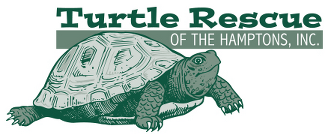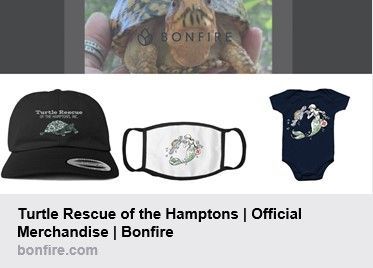How to Identify a Turtle
Turtle Rescue of the Hamptons
We Do Not Have Any Ocean Species, Do Not Release Any Species Into The Ocean
Native Turtle Knowledge
Turtles are reptiles that are either land-based (terrestrial) or water-based (aquatic). They are characterized by a bony shell that shields their soft body (the shell is attached to the body at rib-like structures). The plates or panels on the turtle’s upper shell (called the carapace) and lower shell (called the plastron) are called scutes. The fossil record indicates that turtles have been around for 220 million years; longer than lizards, snakes, and crocodiles. Being an ectotherm, the internal temperature of a turtle varies with the outside temperature. This is why you can see a turtle basking in the sun to warm up before moving around or eating insects, snails, or worms. Turtles also hibernate during the winter to conserve energy and body mass when food is not readily available. Turtles can live to be over 100 years.
Remember, turtles are government-protected animals and should never be removed from the wild (it’s against the law). Please DO NOT remove a turtle from its habitat. Their very specialized needs can not be fully met out of the wild. If they are removed they have issues leading to illness, organ failure, and death. Please call Turtle Rescue of the Hamptons if you see an ill/injured turtle, or if you have questions about where a particular turtle lives.
The East End of Long Island is home to a variety of turtles. Many of these turtles are also present throughout the Northeast. Turtles are very active during the early spring months when they wake from hibernation and move about looking for food, mates, and places to nest. Here are a few facts to help you identify the turtles you may encounter on Long Island.
Mud Turtle
*Endangered in NYS*
The Eastern Mud Turtle is a small turtle measuring 3 to 4 inches with a smooth, almost patternless carapace that ranges from olive green to almost black. The plastron is yellow to brown. These are semi-aquatic turtles and are found in fresh or brackish water including marshes, small ponds, wet ditches and fields, and on offshore islands. They prefer shallow, slow-moving water with a sandy bottom and abundant vegetation, and they can move 1,000 feet or more to find sandy soil to nest. The Eastern Mud Turtle is listed as endangered by the New York State Department of Environmental Conservation.
Painted Turtle
The Painted Turtle is 4 to 10 inches long and has a smooth black-brown carapace with a yellow plastron. The soft body is olive green to black with red, orange, or yellow stripes. This turtle lives in slow-moving fresh water and consumes vegetation and small water creatures including insects, crustaceans, and fish, but will spend hours basking in the sun. Painted Turtles mate in spring and in autumn so they are often on the move. Still the most abundant turtle in the United States, its number nevertheless has been greatly reduced by habitat removal and road accidents. They are often confused with the Red-Eared Slider, a highly invasive species.
Eastern Box Turtle
*Special Concern*
Eastern Box Turtles have a dome-like carapace that is brown to black with yellow or orange lines and blotches radiating in a circular pattern around the shell. The soft body also exhibits some yellow, orange, red, or white spots or streaks. Males can have red eyes while females have brown eyes. The carapace and plastron are hinged allowing the animal to withdraw completely into the shell. The mouth has a sharp horned beak. Most Box Turtles are small and range in size from 4.5 to 6 inches. Box Turtles are considered the only land turtle in the United States (as distinguished from tortoises, which are different). They prefer forests with cool, moist floors and often hibernate in decaying leaves. Box Turtles feed on earthworms, snails, slugs, beetles, fruits, berries, and grasses and are very beneficial to the environment.
Diamondback Terrapin
The Diamondback Terrapin inhabits brackish water exclusively and is so named for the diamond-shaped patterns on its carapace. The upper shell can be brown to gray and is distinctive for being wider in the back than it is in the front. The soft body can be gray, brown, yellow, or white and has a distinctive pattern of black spots on the face and neck. Terrapins range in size from 4.5 to 6.75 inches. As an aquatic species, terrapins have large webbed feet and can adapt to surviving in a variety of salinities, including full-strength salt water, for an extended period of time. They live close to the shoreline and do not migrate very far. Females do, however, produce an abundance of offspring: up to three clutches of eggs in the wild per year, numbering from 4 to 22 eggs in each clutch. They are usually laid in sandy dunes near where they live. Terrapins mainly eat crustaceans, including shrimp, mussels, clams, and crabs. They are most threatened by the development of marshy lands in their range.
Spotted Turtle
*Threatened*
Sometimes called a “polka dot” turtle, the Spotted Turtle has yellow spots on its head, neck, legs, and carapace over a black background. The number of yellow spots increases with age. The plastron is yellow and black in color. They live in wet, grassy areas near freshwater ponds and they eat snails, worms, slugs, and spiders. Spotted Turtles measure 3.5 to 5.0 inches, but hatchlings (which are new babies) measure only one inch! Spotted Turtles wander a great distance from their pools in search of nesting areas, and many are killed crossing roadways. They prefer meadows or fields but have been known to dig a nest by the sandy side of a road. By contrast, the Spotted Turtle lays only 3 to 4 eggs at a time. Once the most common turtle in the New York region, its population has been reduced by the loss of habitat and by the widespread use of fertilizers and other toxic pollutants, which destroy water quality.
Hatchlings
Baby turtles are called hatchlings. Newborn turtles are very small – often smaller than the size of a quarter – so it is very hard to know where they are while you are walking or doing yard work. Please be careful if you see an active turtle nest. Hatchlings remain by the nest in the first week but then move off to forage. From the time of their hatching, hatchlings are completely independent and never see or interact with either of their parents. If they are bright-eyed, have no apparent injuries, and are active, please leave them alone. Never release a hatchling, they all look similar, text a picture for a quick id health check, so you don't release an aquatic turtle in the woods.
Hatchlings incubate in the ground for approximately 80 days. Do not cover the nest. They usually emerge on a rainy day, if temperatures are not warm enough they may over winter in their nest and emerge next spring.
Common Snapping Turtle
*State Reptile of NY*
Snapping Turtles live in freshwater ponds and streams. They have muscular soft bodies that are “pebbly” in appearance not unlike the hide of an alligator. Their feet have long talons and their tails have small ridges; the carapace of an adult is marked by a distinctive ridge and has muted colors of yellow and brown. Snapping Turtles can grow large – up to 20 inches in carapace length and up to 35 pounds in weight. They consume both plants and animals and are important aquatic scavengers because they eat carrion (dead animals). Snapping Turtles travel far from their water source to reach new habitats to lay their eggs, driven by food scarcity, overcrowding, or habitat destruction. A single female can lay up to 80 eggs per year.
Because Snapping Turtles cannot completely withdraw into their shells, they have evolved the ability to snap as a defense mechanism against predators, though they will rarely bite humans. The Snapping Turtle uses its beak-like jaws to ambush and capture prey. DO NOT pick up a Snapping Turtle by its tail, as the tail is an extension of the spinal column and the animal can be permanently injured. PLEASE call Turtle Rescue if you see an injured Snapping Turtle; we are trained to handle Snappers and can make sure that the animal and rescuer remain safe. These turtles eat mostly vegetation and consume their body weight in protein (meat) once a year. Considered a keystone species, they are part of nature's clean-up crew.




Share On: